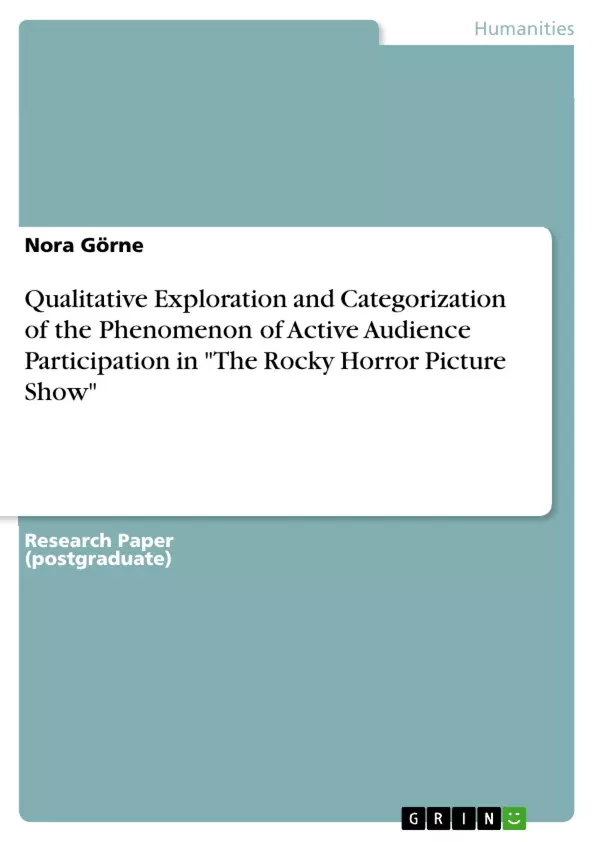The Rocky Horror Picture Show (RHPS), a film by Richard O'Brien, is probably the longest-running release in the history of moving picture with regular screenings (The Official Fan Site) since its release in 1975. Apart from that, also the screenings itself have a notorious tradition as most of them involve what is called by their fans audience participation. That means that the spectators are expected to actively involve in the story of the film by for example dressing up like one of the characters and calling responses to the screen and by that breaking with the traditional conventions of cinema etiquettes.
Till now, research mainly investigated active audience participation as part of the so-called Rocky Horror cult but it was hardly ever studied as a phenomenon of its own taking into account theories about reception process, emotion theory and tension, a gap which this paper tries to fill. After all, active audience participation is not limited to The Rocky Horror Picture Show but can also be found in a few other films and this research can therefore also give implications for the perception and reception of films like The Room (2003) or Hedwig (2001) which screenings also involve active audience participation.
The goal of this research is therefore to historically, theoretically, analytically and empirically explore and categorize the phenomenon of active audience participation in the case of The Rocky Horror Picture Show. Specifically, it will test the hypothesis that especially for fans the screenings become a form of an event where the film itself is of secondary importance and show that active audience participation has to be considered as being part of a wider tension concept.
In particular, the research will focus on three main research questions on which the structure of this paper is based. After explaining the theoretical framework which includes definitions for the used terms and then the methodology, the first question, when, how and why the active audience participation in The Rocky Horror Picture Show evolved, will be answered. Thereafter, the function and importance of this active audience participation for the fans will be analysed. Thirdly, it will be examined to what extent active audience participation influences the perception and experience of first-time viewers of The Rocky Horror Picture Show. At the end, a short summary, general conclusions and a short discussion with suggestions for further research will be given.
Table of Contents
- Introduction
- Theoretical Framework
- Methodology
- The Evolution of Audience Participation in The Rocky Horror Picture Show
- The Function and Importance of Audience Participation for the Fans
- Audience Participation and First-Time Viewers
- Conclusion
Objectives and Key Themes
This research aims to explore and categorize the phenomenon of active audience participation in The Rocky Horror Picture Show. It seeks to answer how this participation evolved, understand its importance for fans, and assess its influence on first-time viewers. The paper will explore the historical development of this phenomenon, analyze its function within the fan community, and examine its impact on the audience's perception and experience of the film.- The evolution of audience participation in The Rocky Horror Picture Show.
- The function and importance of audience participation for the fans.
- The influence of audience participation on the perception and experience of first-time viewers.
- The relationship between active audience participation and the concept of tension in film reception.
- The role of pre-show rituals and shadow casts in shaping the audience's experience.
Chapter Summaries
- Introduction: This chapter provides a brief overview of The Rocky Horror Picture Show, its long-running popularity, and the unique tradition of audience participation that surrounds it. It highlights the lack of research on this phenomenon, focusing on its individual characteristics and its implications for other films with active audience involvement.
- Theoretical Framework: This chapter defines key terms like "audience participation," "tension," and "excitement" in the context of film reception theory. It introduces the concept of tension in relation to the non-fiction and aesthetical modes of film experience, using Schoenmaker's application of Frijda's emotion theory.
- Methodology: This chapter discusses the research methods used to address the study's research questions, including historical research, theoretical analysis, and empirical observation. It highlights the challenges of accessing primary sources and the need to consider the inherent subjectivity of fan-generated materials.
- The Evolution of Audience Participation in The Rocky Horror Picture Show: This chapter investigates the historical development of audience participation in The Rocky Horror Picture Show, drawing upon available resources like fan websites, books, and magazines. It explores how and why this practice emerged and examines its evolution over time.
- The Function and Importance of Audience Participation for the Fans: This chapter delves into the function and significance of audience participation for fans of The Rocky Horror Picture Show. It examines how active participation contributes to the film's unique experience and its role in shaping fan culture and community.
- Audience Participation and First-Time Viewers: This chapter explores the impact of audience participation on first-time viewers of The Rocky Horror Picture Show. It investigates whether pre-existing knowledge of this phenomenon enhances the excitement and enjoyment of the viewing experience for new audiences.
Keywords
This research focuses on the phenomenon of active audience participation in The Rocky Horror Picture Show, exploring its historical evolution, function for fans, and impact on first-time viewers. Key terms include audience participation, tension, excitement, reception theory, fan culture, and the non-fiction and aesthetical modes of film experience.- Arbeit zitieren
- Nora Görne (Autor:in), 2011, Qualitative Exploration and Categorization of the Phenomenon of Active Audience Participation in "The Rocky Horror Picture Show", München, GRIN Verlag, https://www.grin.com/document/184345



